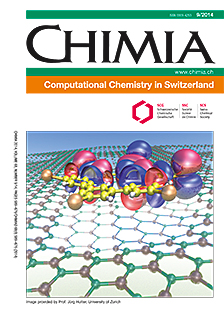Lessons from Nature: Computational Design of Biomimetic Compounds and Processes
DOI:
https://doi.org/10.2533/chimia.2014.642Keywords:
Biomimetic compounds, Computational enzyme design, Density functional theory, Dye-sensitized solar cells, Green chemistry, Mixed quantum mechanical-molecular mechanical (qm/mm) simulations, Natural catalystsAbstract
Through millions of years of evolution, Nature has accomplished the development of highly efficient and sustainable processes and the idea to understand and copy natural strategies is therefore very appealing. However, in spite of intense experimental and computational research, it has turned out to be a difficult task to design efficient biomimetic systems. Here we discuss a novel strategy for the computational design of biomimetic compounds and processes that consists of i) target selection; ii) atomistic and electronic characterization of the wild type system and the biomimetic compounds; iii) identification of key descriptors through feature selection iv) choice of biomimetic template and v) efficient search of chemical and sequence space for optimization of the biomimetic system. As a proof-of-principles study, this general approach is illustrated for the computational design of a 'green' catalyst mimicking the action of the zinc metalloenzyme Human Carbonic Anhydrase (HCA). HCA is a natural model for CO2 fixation since the enzyme is able to convert CO2 into bicarbonate. Very recently, a weakly active HCA mimic based on a trihelical peptide bundle was synthetized. We have used quantum mechanical/molecular mechanical (QM/MM) Car-Parrinello simulations to study the mechanisms of action of HCA and its peptidic mimic and employed the obtained information to guide the design of improved biomimetic analogues. Applying a genetic algorithm based optimization procedure, we were able to re-engineer and optimize the biomimetic system towards its natural counter part. In a second example, we discuss a similar strategy for the design of biomimetic sensitizers for use in dye-sensitized solar cells.Downloads
Published
2014-09-24
Issue
Section
Scientific Articles
License
Copyright (c) 2014 Swiss Chemical Society

This work is licensed under a Creative Commons Attribution-NonCommercial 4.0 International License.
How to Cite
[1]
E. Bozkurt, N. Ashari, N. Browning, E. Brunk, P. Campomanesa, M. A. S. Perez, U. Rothlisberger, Chimia 2014, 68, 642, DOI: 10.2533/chimia.2014.642.







